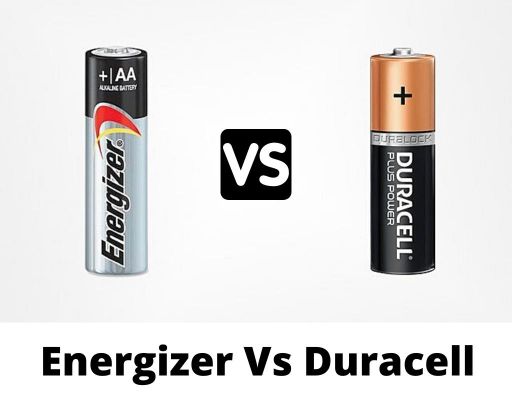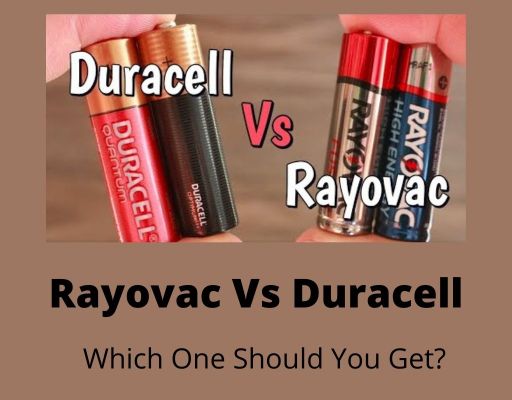AA batteries are one of the most common battery sizes found in household electronic devices. An AA battery is made up of a single electrochemical cell that can be either primary or rechargeable.
Digital thermometers, calculators, laser pens, flashlights, electronic toys, smoke detectors, medical devices and instruments, memory backup, and battery pack applications are just a few of the applications for AA Batteries.
D batteries are typically employed in high-drain applications such as flashlights, automated odorizers, paper towel machines, transmitters, radio receivers, and other devices that demand a long run time.
Now, let’s read a detailed comparison between AA Battery vs D Batteries below.
AA Battery Vs D Battery: Quick Comparison Table
There are several differences between an AA battery and a D battery. To examine the variations between the characteristics, look at the table below.
| Features | AA Battery | D Battery |
| Voltage | 1.5 Volts | 1.5 Volts |
| Battery Types | Alkaline, NiZN, NiMH, NiCd, Lithium | Alkaline, NiMH, LiSoCl2, NiCd, Carbon Zinc, Lithium |
| Height | Almost 50.0 mm | 46.40 – 48.50 mm |
| Length | 49.2–50.5 mm (1.94–1.99 inches) | 61.5 mm (2.42 inches) |
| Width / Diameter | 13.5–14.5 mm | 33.2 ± 1 mm (1.3 inches) |
| Capacity | 2000 to 3000mAh | 3000 to 20000mAh |
| Applications | Calculator, Wireless, Doorbells, Flashlight, Digital Thermometer, Wireless Keyboard, Mice. | Megaphones, Radio Receiving and Transmitting Equipment. |
| Cost | $0.6 – 1.2 | $1.6 – 3.0 |
| Lifetime | 5 – 15 Years | 2 – 3 Years |
What Are the Difference Between AA Battery and D Battery Based on Features?
Voltage:
AA battery-powered appliances and equipment are typically intended to operate between 0.9 and 1.5 volts. As AA batteries have a lower voltage, they may maintain a consistent discharge rate of roughly 1.0V throughout their operation.
The voltage of standard D batteries is 1.5 volts. The current generated by various battery sizes is also important. With its flat discharge curve, it has steady performance.
Although AA alkaline batteries offer a greater beginning voltage of 1.5V, they progressively lose that voltage over time, lowering the device’s performance. So. Type D is better than AA batteries.
Battery Types:
The AA battery types are Zinc Carbon, Li-FeS2, Li-ion, LiFePO4, Li-SOCl2, Li-MnO2, NiOOH, NiZn, NiMH, NiCd, Alkaline, and Lithium. Rechargeable ones are Lithium, NiCd, NiMH, NiZn, Li-ion, and LiFePO4.
Alkaline, Lithium, Zinc Carbon, or Lithium Iron Disulfide (LiFeS2) batteries are the most common types of D batteries. As in the case of RAMs and Lithium-ion or rechargeable Lithium, both Alkaline and Lithium offer rechargeable forms.
The best battery chemistry is Li-ion, Lead Acid, LiFePO4, NiCd, and NiMH. So, I may conclude that AA batteries are preferable to D batteries.
Dimensions:
Because of their compact dimensions, AA batteries are widely used in portable electronic gadgets. The length of an AA cell, including the button terminal, is 49.2–50.5 mm, while the diameter is 13.5–14.5 mm.
D-type batteries have a cylindrical form. The diameter is 33.0 to 34.20 mm, while the height or length is 58.0 to 61.50 mm.
Type D batteries have a larger form and provide less voltage than AA batteries. If you wish to use it for light electronic devices, an AA battery is considerably better.
Capacity:
The capacity of primary (non-rechargeable) zinc-carbon (dry cell) AA batteries is 400–900mAh. The capacity of alkaline batteries decreases dramatically as the discharge current rises.
The capacity of D batteries is determined by the amount of current consumed. The capacity is around 20,000mAh at 25mA draw and 10,000mAh at 500mA draw.
An AA battery has a capacity of 2.5 AH, whereas a D battery has a capacity of 12 AH. So, the D-type battery delivers a higher current flow than the AA battery.
Applications:
Wall clocks, cordless phones, smaller flashlights, TV remotes, games and toys, handheld culinary or grooming devices, and a variety of portable audiovisual technologies all use alkaline AA batteries.
Type D batteries are commonly used in torches, radios, smart watches, Bluetooth equipment, children’s toys, sports shoes, and other similar devices.
D kinds are the ideal choice if the gadget requires power for a lengthy period, such as 24 to 48 hours.
Lifetime:
AA batteries typically last 5-10 years depending on a variety of circumstances. A 2,500mAh AA alkaline battery could run a gadget that consumes 250mA of electricity for 10 hours.
If used at a consumption rate of 500 mAh, the Type D battery should last approximately 15 hours. Rechargeable batteries only last two to three years before running out of power.
So, if you want a long lifetime, the AA batteries are better. But if you want more time from a single charge, type D batteries are better.
AA Battery or D Battery Which One to Choose?
The choice is influenced by several factors. A D-type battery is a method to go if the gadget you’re utilizing the battery on has a long run time.
D-type main batteries offer high specific energy and long storage life. These are likewise low-cost and require little maintenance. They are also environmentally friendly.
If you’re looking for a battery for your portable device, an AA battery is the best option. So, the solution is contingent on your needs.
If you need extra capacity, a Type D battery is preferred over an AA battery.
However, if you need a battery for handheld devices and lengthy periods, and the larger size isn’t an issue for you, I recommend D batteries.
Frequently Asked Questions (FAQs):
u003cstrongu003eWhat is equivalent to a type AA battery?u003c/strongu003e
BA-30, LR20, R20, MX1300, MN1300, 13A, 13D, and type 373 are the finest type D battery equivalents.
u003cstrongu003eWhat is equivalent to a type D battery?u003c/strongu003e
15LF, U12, FR6, HP7, MV1500, MN1500, 15D, 15A, R6, and 316 are the best type D battery equivalents.
u003cstrongu003eWhich type AA battery chemistry has the highest capacity?u003c/strongu003e
The non-rechargeable, Li-FeS2 has the highest capacity which is 2700 – 3700 mAh. The common names are FR6 and 15LF.
u003cstrongu003eWhich type D battery chemistry has the highest capacity?u003c/strongu003e
The Li-FeS2 chemistry type D batteries have the highest capacity of 18 – 24 Ah.
u003cstrongu003eCan type AA replace type D batteries?u003c/strongu003e
It is safe to use type AA instead of type D batteries since the device will only draw the required current.
Product Suggestions for Type AA and D Batteries
There are different types of batteries on the market. Check out the list below to get the finest AA and D batteries.
Type AA Battery:
- Energizer Ultimate Lithium AA Battery
– It can function in temperatures ranging from -40°C to 60°C.
– It’s 33% lighter than an alkaline battery of the same size. - Duracell Optimum Type AA Battery for High-Drain Devices
– It comes in cardboard packaging that is simple to open.
– For high workloads, this is the better option.
Type D Battery:
– It has a higher capacity and delivers excellent results.
– It is long-lasting and cost-effective.2
2. Duracell Copper Top D Batteries
– Ideal for high-usage gadgets.
– It is long-lasting and has a huge capacity.
Summary
I’ve shared a lot of information on AA and D batteries. When purchasing a battery for a gadget, the voltage, capacity, size, and pricing should all be considered.
If your gadget requires greater voltage but you’re good with a heavier battery, I recommend the D battery.
After reading this article, you should be able to find a battery that matches your requirements.


